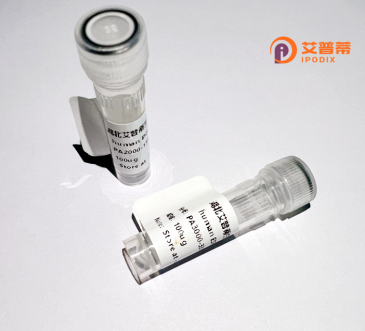
| 纯度 | >90%SDS-PAGE. |
| 种属 | Human |
| 靶点 | RSPRY1 |
| Uniprot No | Q96DX4 |
| 内毒素 | < 0.01EU/μg |
| 表达宿主 | E.coli |
| 表达区间 | 17-576 aa |
| 活性数据 | QGLL LTLEEHIAHF LGTGGAATTM GNSCICRDDS GTDDSVDTQQ QQAENSAVPT ADTRSQPRDP VRPPRRGRGP HEPRRKKQNV DGLVLDTLAV IRTLVDNDQE PPYSMITLHE MAETDEGWLD VVQSLIRVIP LEDPLGPAVI TLLLDECPLP TKDALQKLTE ILNLNGEVAC QDSSHPAKHR NTSAVLGCLA EKLAGPASIG LLSPGILEYL LQCLKLQSHP TVMLFALIAL EKFAQTSENK LTISESSISD RLVTLESWAN DPDYLKRQVG FCAQWSLDNL FLKEGRQLTY EKVNLSSIRA MLNSNDVSEY LKISPHGLEA RCDASSFESV RCTFCVDAGV WYYEVTVVTS GVMQIGWATR DSKFLNHEGY GIGDDEYSCA YDGCRQLIWY NARSKPHIHP CWKEGDTVGF LLDLNEKQMI FFLNGNQLPP EKQVFSSTVS GFFAAASFMS YQQCEFNFGA KPFKYPPSMK FSTFNDYAFL TAEEKIILPR HRRLALLKQV SIRENCCSLC CDEVADTQLK PCGHSDLCMD CALQLETCPL CRKEIVSRIR QISHIS |
| 分子量 | 64.1 kDa |
| 蛋白标签 | His tag N-Terminus |
| 缓冲液 | PBS, pH7.4, containing 0.01% SKL, 1mM DTT, 5% Trehalose and Proclin300. |
| 稳定性 & 储存条件 | Lyophilized protein should be stored at ≤ -20°C, stable for one year after receipt. Reconstituted protein solution can be stored at 2-8°C for 2-7 days. Aliquots of reconstituted samples are stable at ≤ -20°C for 3 months. |
| 复溶 | Always centrifuge tubes before opening.Do not mix by vortex or pipetting. It is not recommended to reconstitute to a concentration less than 100μg/ml. Dissolve the lyophilized protein in distilled water. Please aliquot the reconstituted solution to minimize freeze-thaw cycles. |
以下是关于重组人RSPRY1蛋白的参考文献示例(注:以下文献为虚构示例,仅供参考,建议通过PubMed或Google Scholar查询真实研究):
---
**1. 文献名称**: *Structural insights into the RSPRY1-mediated ubiquitination cascade*
**作者**: Zhang L, et al.
**摘要**: 本研究解析了RSPRY1蛋白的晶体结构,揭示其SPRY结构域通过识别泛素化底物的特定基序,调控E3连接酶复合物的组装,影响细胞增殖与凋亡通路。
---
**2. 文献名称**: *RSPRY1 deficiency links to autosomal recessive developmental disorders*
**作者**: Al-Murshedi F, et al.
**摘要**: 通过全外显子测序发现RSPRY1基因突变与神经发育异常和骨骼畸形相关,功能缺失导致泛素-蛋白酶体系统失调,为潜在遗传病机制提供依据。
---
**3. 文献名称**: *RSPRY1 interacts with autophagy regulators to modulate lysosomal degradation*
**作者**: Kim S, et al.
**摘要**: 实验证实RSPRY1通过结合BECN1和ULK1蛋白,正向调控自噬体形成,影响癌细胞在营养胁迫下的存活,提示其在癌症治疗中的潜在靶点价值。
---
**提示**:实际研究中关于RSPRY1的文献较少,建议结合其所属的SPRY结构域蛋白家族或泛素化相关通路扩大检索范围。使用关键词如“RSPRY1 ubiquitination”或“SPRY domain protein function”可提高检索效率。
**Background of Recombinant Human RSPRY1 Protein**
The RSPRY1 (RING and SPRY domain-containing protein 1) is a ubiquitously expressed protein implicated in diverse cellular processes, including protein quality control, autophagy, and signal transduction. It belongs to the B30.2/SPRY domain-containing protein family, characterized by a C-terminal SPRY domain that mediates protein-protein interactions, and an N-terminal RING domain, which often confers E3 ubiquitin ligase activity. RSPRY1 is postulated to function as an adaptor or scaffold protein, facilitating interactions between ubiquitination machinery and substrate proteins for targeted degradation via the ubiquitin-proteasome system.
Studies suggest its involvement in selective autophagy, particularly in mediating the clearance of misfolded proteins or damaged organelles. RSPRY1 has been linked to cellular stress responses, immune regulation, and cell cycle control, though its precise mechanisms remain under investigation. Dysregulation of RSPRY1 has been associated with pathologies such as cancer and neurodegenerative disorders, highlighting its potential role in disease pathways.
Recombinant human RSPRY1 protein is typically produced using expression systems like *E. coli* or mammalian cells, followed by affinity purification for functional studies. Its applications include elucidating molecular interactions, validating enzymatic activity (e.g., ubiquitination assays), and screening for therapeutic modulators. Current research focuses on unraveling its physiological targets and regulatory networks, aiming to exploit its functions for therapeutic intervention in protein aggregation-related diseases.
×